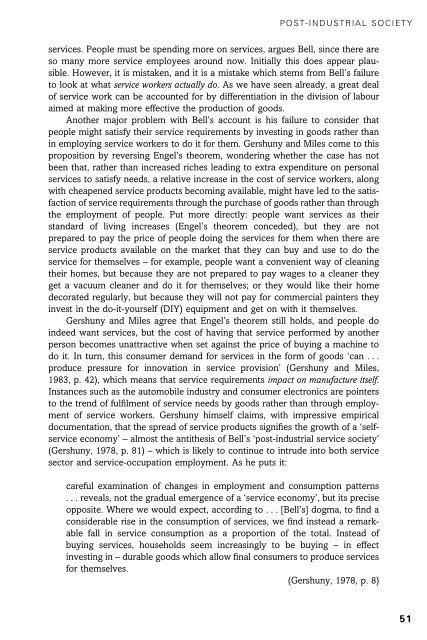Theories of the Information Society, Third Edition - Cryptome
Theories of the Information Society, Third Edition - Cryptome
Theories of the Information Society, Third Edition - Cryptome
You also want an ePaper? Increase the reach of your titles
YUMPU automatically turns print PDFs into web optimized ePapers that Google loves.
POST-INDUSTRIAL SOCIETY<br />
1<br />
1<br />
1<br />
2<br />
1<br />
1<br />
services. People must be spending more on services, argues Bell, since <strong>the</strong>re are<br />
so many more service employees around now. Initially this does appear plausible.<br />
However, it is mistaken, and it is a mistake which stems from Bell’s failure<br />
to look at what service workers actually do. As we have seen already, a great deal<br />
<strong>of</strong> service work can be accounted for by differentiation in <strong>the</strong> division <strong>of</strong> labour<br />
aimed at making more effective <strong>the</strong> production <strong>of</strong> goods.<br />
Ano<strong>the</strong>r major problem with Bell’s account is his failure to consider that<br />
people might satisfy <strong>the</strong>ir service requirements by investing in goods ra<strong>the</strong>r than<br />
in employing service workers to do it for <strong>the</strong>m. Gershuny and Miles come to this<br />
proposition by reversing Engel’s <strong>the</strong>orem, wondering whe<strong>the</strong>r <strong>the</strong> case has not<br />
been that, ra<strong>the</strong>r than increased riches leading to extra expenditure on personal<br />
services to satisfy needs, a relative increase in <strong>the</strong> cost <strong>of</strong> service workers, along<br />
with cheapened service products becoming available, might have led to <strong>the</strong> satisfaction<br />
<strong>of</strong> service requirements through <strong>the</strong> purchase <strong>of</strong> goods ra<strong>the</strong>r than through<br />
<strong>the</strong> employment <strong>of</strong> people. Put more directly: people want services as <strong>the</strong>ir<br />
standard <strong>of</strong> living increases (Engel’s <strong>the</strong>orem conceded), but <strong>the</strong>y are not<br />
prepared to pay <strong>the</strong> price <strong>of</strong> people doing <strong>the</strong> services for <strong>the</strong>m when <strong>the</strong>re are<br />
service products available on <strong>the</strong> market that <strong>the</strong>y can buy and use to do <strong>the</strong><br />
service for <strong>the</strong>mselves – for example, people want a convenient way <strong>of</strong> cleaning<br />
<strong>the</strong>ir homes, but because <strong>the</strong>y are not prepared to pay wages to a cleaner <strong>the</strong>y<br />
get a vacuum cleaner and do it for <strong>the</strong>mselves; or <strong>the</strong>y would like <strong>the</strong>ir home<br />
decorated regularly, but because <strong>the</strong>y will not pay for commercial painters <strong>the</strong>y<br />
invest in <strong>the</strong> do-it-yourself (DIY) equipment and get on with it <strong>the</strong>mselves.<br />
Gershuny and Miles agree that Engel’s <strong>the</strong>orem still holds, and people do<br />
indeed want services, but <strong>the</strong> cost <strong>of</strong> having that service performed by ano<strong>the</strong>r<br />
person becomes unattractive when set against <strong>the</strong> price <strong>of</strong> buying a machine to<br />
do it. In turn, this consumer demand for services in <strong>the</strong> form <strong>of</strong> goods ‘can . . .<br />
produce pressure for innovation in service provision’ (Gershuny and Miles,<br />
1983, p. 42), which means that service requirements impact on manufacture itself.<br />
Instances such as <strong>the</strong> automobile industry and consumer electronics are pointers<br />
to <strong>the</strong> trend <strong>of</strong> fulfilment <strong>of</strong> service needs by goods ra<strong>the</strong>r than through employment<br />
<strong>of</strong> service workers. Gershuny himself claims, with impressive empirical<br />
documentation, that <strong>the</strong> spread <strong>of</strong> service products signifies <strong>the</strong> growth <strong>of</strong> a ‘selfservice<br />
economy’ – almost <strong>the</strong> anti<strong>the</strong>sis <strong>of</strong> Bell’s ‘post-industrial service society’<br />
(Gershuny, 1978, p. 81) – which is likely to continue to intrude into both service<br />
sector and service-occupation employment. As he puts it:<br />
careful examination <strong>of</strong> changes in employment and consumption patterns<br />
. . . reveals, not <strong>the</strong> gradual emergence <strong>of</strong> a ‘service economy’, but its precise<br />
opposite. Where we would expect, according to . . . [Bell’s] dogma, to find a<br />
considerable rise in <strong>the</strong> consumption <strong>of</strong> services, we find instead a remarkable<br />
fall in service consumption as a proportion <strong>of</strong> <strong>the</strong> total. Instead <strong>of</strong><br />
buying services, households seem increasingly to be buying – in effect<br />
investing in – durable goods which allow final consumers to produce services<br />
for <strong>the</strong>mselves.<br />
(Gershuny, 1978, p. 8)<br />
51
















